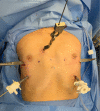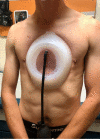The management of pectus excavatum in pediatric patients: a narrative review
- PMID: 36891368
- PMCID: PMC9986778
- DOI: 10.21037/tp-22-361
The management of pectus excavatum in pediatric patients: a narrative review
Abstract
Background and objective: Pectus excavatum is the most common congenital chest wall anomaly, the hallmark of which is the caved-in appearance of the anterior chest. A growing body of literature exists surrounding methods of surgical correction, though considerable variability in management remains. The primary objectives of this review are to outline the current practices surrounding the care of pediatric patients with pectus excavatum and present emerging trends in the field that continue to impact the care of these patients.
Methods: Published material in English was identified utilizing the PubMed database using multiple combinations of the keywords: pectus excavatum, pediatric, management, complications, minimally invasive repair of pectus excavatum, MIRPE, surgery, repair, and vacuum bell. Articles from 2000-2022 were emphasized, though older literature was included when historically relevant.
Key content and findings: This review highlights contemporary management principles of pectus excavatum in the pediatric population, comprising preoperative evaluation, surgical and non-surgical treatment, postoperative considerations including pain control, and monitoring strategies.
Conclusions: In addition to providing an overview of pectus excavatum management, this review highlights areas that remain controversial including the physiologic effects of the deformity and the optimal surgical approach, which invite future research efforts. This review also features updated content on non-invasive monitoring and treatment approaches such as three-dimensional (3D) scanning and vacuum bell therapy, which may alter the treatment landscape for pectus excavatum in order to reduce radiation exposure and invasive procedures when able.
Keywords: Nuss procedure; Pectus excavatum; minimally invasive repair of pectus excavatum (MIRPE); vacuum bell.
2023 Translational Pediatrics. All rights reserved.
Conflict of interest statement
Conflicts of Interest: Both authors have completed the ICMJE uniform disclosure form (available at https://tp.amegroups.com/article/view/10.21037/tp-22-361/coif). Farokh R. Demehri serves as an unpaid editorial board member of Translational Pediatrics from February 2021 to January 2023. The other author has no conflicts of interest to declare.
Figures



Comment in
-
Raising the bar in the management of pectus excavatum.Transl Pediatr. 2023 Jun 30;12(6):1059-1062. doi: 10.21037/tp-23-236. Epub 2023 May 31. Transl Pediatr. 2023. PMID: 37427063 Free PMC article. No abstract available.
-
Evolution in the management of pectus excavatum in pediatric patients.Transl Pediatr. 2023 Aug 30;12(8):1450-1453. doi: 10.21037/tp-23-264. Epub 2023 Jul 28. Transl Pediatr. 2023. PMID: 37692546 Free PMC article. No abstract available.
References
Publication types
LinkOut - more resources
Full Text Sources
